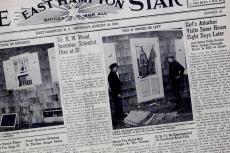In the early morning of April 14, 1964, East Hampton Village police were notified of smoke emerging from the Edwards Theater. Sgt. Joseph Loris (1927-2001) alerted the East Hampton Fire Department, and firefighters arrived to see smoke pouring out of the building, signaling a much more serious fire within.
The firemen entered the theater to assess the situation and realized that the flames originated from above the lobby ceiling and under the theater seats. After several failed attempts at taming the blaze from inside, they exited the building, determined to put out the fire externally. This photograph from The East Hampton Star’s archive shows firemen fighting flames hidden behind the theater’s facade.
That fight was short-lived, as the fire broke through the roof and traveled to the rear of the building. Despite the firemen’s efforts to hose down the conflagration, the roof of the theater collapsed, and soon the southwest and northeast walls fell. Clearly there would be no showing of the advertised “Captain Newman, M.D.” at the Edwards Theater that night.
The fire was extinguished after several hours with aid from neighboring fire departments. The theater and several other businesses within the building, such as the Marmador restaurant, A.C. Osborne Jewelry, and the surveying office of Geoffrey Bass (1902-1965), were destroyed.
The fire was caused by faulty wiring under the theater seats. The damage to all five businesses in the building was estimated at around half a million dollars at the time, or around $5 million today. Although other businesses in the building relocated, Herman Ficken, the eastern Suffolk district manager of the Prudential Theaters chain, promised that the theater would be reconstructed in the same location.
Ficken’s promise came true in the summer of 1965, when Leonard Edwards (1899-1975), son of the theater’s founder, LeRoy Edwards (1875-1947), opened the East Hampton Theater. Since then, the building has been expanded and renovated into the current five-screen Regal UA theater on Main Street.
—
Megan Bardis is a librarian and archivist in the Long Island Collection.




